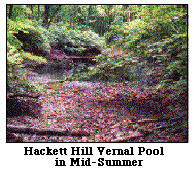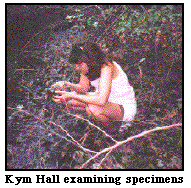Vernal
pools in themselves have complicated "webs" of prey-predator
relationships, whether they are as small in size as a few square
feet, or larger than a football field. As summer turns into fall,
leaves accumulate in what has become a nearly dry depression, and
eventually undergo decomposition by microorganisms such as bacteria
and fungi. In the winter, the depression will be filled with snow and
by spring, due to melting and  run-off, a substantial amount of water may have
accumulated in it. Certain species of frogs and salamanders return
annually to breed and lay eggs in the pools, which are free of fish
that might prey upon the eggs. Various insects also deposit eggs in
the pool.
run-off, a substantial amount of water may have
accumulated in it. Certain species of frogs and salamanders return
annually to breed and lay eggs in the pools, which are free of fish
that might prey upon the eggs. Various insects also deposit eggs in
the pool.
Elaborate "feeding webs" appear within vernal pools during the spring. In some instances, maturing larval insect or amphibian forms feed upon leaf remnants or microorganisms. Developing forms of other insects, i.e., the water beetle and dragonfly feed upon smaller larvae; and larger animals such as turtles, snakes and wading birds may eat egg masses, various large larval forms, or adult amphibians. Owls may also appear and capture amphibians.
On the Hackett Hill property, the location of a vernal pool in close proximity to a swamp would suggest there might be an interdependence between the two habitats, since certain insect forms such as dragonflies are typically associated both with vernal pools and swamps.
However, many of the vernal pools on the Hackett Hill property are located at a considerable distance from the swamp communities, and are located outside the boundary of the planned Preserve. During the spring of 1999, an inventory of four Hackett Hill vernal pools was completed by Kym Hall, a graduate student at Antioch New England Graduate School. The area of the largest of these pools totals 1125 m2. Its depth is approximately 5 feet in the early spring. It is located in forestland at the base of a rocky cliff, at least a half mile distant from the nearest swamp.
 Kym determined the presence or absence in the four vernal
pools of certain amphibia which are obligate vernal pool breeders,
i.e., these species require the presence of vernal pools for
reproduction. As the pool begins to dry up , adults and maturing
forms move into moist areas of forestland. Kym's findings indicated
that two species, the spotted salamander and the wood frog, were
present in the pools she examined. She then determined the relative
abundance of the adult amphibia and their egg masses. As a result of
data which Kym submitted to the NH Department of Fish and Game, the
pool mentioned above may be considered for "certification" - a
designation that indicates it is worthy of protection.
Kym determined the presence or absence in the four vernal
pools of certain amphibia which are obligate vernal pool breeders,
i.e., these species require the presence of vernal pools for
reproduction. As the pool begins to dry up , adults and maturing
forms move into moist areas of forestland. Kym's findings indicated
that two species, the spotted salamander and the wood frog, were
present in the pools she examined. She then determined the relative
abundance of the adult amphibia and their egg masses. As a result of
data which Kym submitted to the NH Department of Fish and Game, the
pool mentioned above may be considered for "certification" - a
designation that indicates it is worthy of protection.
If vernal pools are destroyed or contaminated as a consequence of construction activities, they will no longer be available for breeding purposes. In this way alone, development clearly has the potential of reducing the population size of Hackett Hill animal species - both in swamps and in forested uplands.
PERTINENT LINK